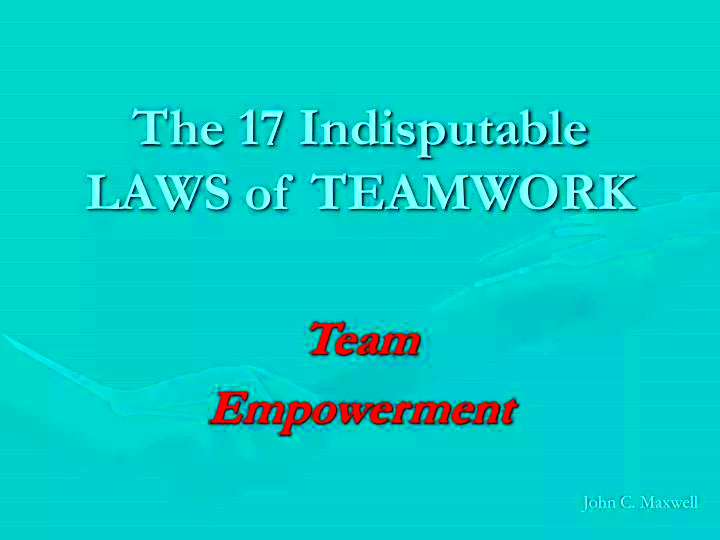How to Apply The 17 Indispensable Laws of Teamwork in the Workplace
When I first heard about the 17 Indispensable Laws of Teamwork, I was skeptical. How could a set of rules truly enhance teamwork? However, as I delved deeper, I realized these laws are more than just guidelines; they are the essence of what makes a team thrive. They remind us that teamwork is not just about tasks but about relationships, emotions, and shared goals.
Every single team member has a part in maintaining these laws as they are of great importance. They create certain feelings of belongingness and accountability among individuals who are part of the team. To illustrate, one such law points out the need for common vision. When I was at my former workplace, there was a time we had a project that looked like an insurmountable task. But our working together was made easy when we came to agree on what direction we were taking hence successfully completing it. From this, I have learnt that it is very important to know and apply these laws so that we can have one united team.
Creating a Culture of Trust in Your Team

Without trust, any strong team is impossible. Collaboration can also become tedious and irritating rather than enjoyable. I remember when I was in a team where there was no trust. Nobody wanted to share their ideas as they were always afraid of being judged. Hence, creativity and innovation thrive in an open atmosphere free from fear or reservation.
To develop trust you may follow these steps:
- Be Transparent: Share information openly to build credibility.
- Encourage Vulnerability: Allow team members to express their fears and challenges.
- Show Appreciation: Recognize individual contributions to foster a sense of belonging.
Once I started expressing my difficulties within the team, this gave a chance to other members of the team to share their own challenges and experiences as well. As a result, it made us closer and consequently enhanced our output.
Encouraging Open Communication Among Team Members

For a team, communication is similar to blood. Without it, misconceptions are developed and disputes turn into worse situations. From personal experience, I have learnt that open communication does not just happen; it takes deliberate action. It involves more than speaking but also entails listening and comprehending each other’s lives.
Here are a few suggestions to promote open communication:
- Regular Check-ins: Schedule weekly meetings to discuss progress and concerns.
- Utilize Technology: Tools like Slack or Microsoft Teams can facilitate real-time discussions.
- Establish an Open-Door Policy: Encourage team members to approach leadership with their thoughts and ideas.
When a system of anonymous feedback was set up, every individual felt at liberty to express their thoughts without fear. Consequently, we had a more interactive and talkative team that could face any challenges as one entity.
Fostering Collaboration for Better Results
Amalgamation encompasses more than merely executing tasks concurrently; it involves integrating our advantages into vaster monuments than us. As I meandered around diverse jobs, I discovered that the finest outcome is frequently produced by teams who fully accept collaboration. If personnel on a team are allowed to say what they want and collaborate towards attainment, then these results can be quite amazing.
These are some steps that are practical in promoting collaboration:
- Create Shared Spaces: Whether physical or virtual, spaces where team members can brainstorm and share ideas are essential.
- Encourage Diverse Perspectives: Invite everyone to contribute, as different viewpoints can lead to innovative solutions.
- Engage in Team-Building Activities: Activities outside of work can strengthen bonds and improve teamwork.
A certain project, I remember, where our team was just stuck. So we decided to drink coffee and hold a brainstorming session. The relaxed ambience helped spur creativity, thus allowing everyone to come up with ideas. By embracing collaboration, we transformed our challenges into success, and everyone was reminded of the strength in unity.
Recognizing and Valuing Each Team Member’s Contribution
In every team, individual capabilities and various approaches are usually brought about by different members. It’s important for improving morale and maintaining a good working atmosphere to identify and appreciate these contributions. I’ve noticed that just a small amount of appreciation can greatly motivate the group members.
You can recognize contributions in a number of ways:
- Public Praise: Celebrate achievements in team meetings or through company newsletters.
- Personal Thank-You Notes: A simple handwritten note can make someone feel appreciated.
- Offer Opportunities for Growth: Encourage members to take on new roles or projects to showcase their skills.
In my prior work, there was a ‘Team Member of the Month’ accolade which sparked not only motivation within individuals but also created a healthy rivalry. The team members’ appreciation leads to an increase in loyalty which directly translates to improved performance.
Setting Clear Goals and Expectations Together
Establishing precise objectives is similar to drafting a guide for your group. In the absence of unambiguous directions, it becomes effortless to stray off course. I have come to understand that when people are in agreement, this results in more efficient processes and superior results achieved together as a team. This collaborative goal-setting process not only includes the members of the team but also gives them power over their lives.
Here is how to set precise objectives:
- Use the SMART Criteria: Ensure goals are Specific, Measurable, Achievable, Relevant, and Time-bound.
- Involve the Team: Encourage team members to contribute to goal-setting discussions, so they feel invested.
- Regularly Review Progress: Schedule periodic check-ins to assess progress and make adjustments if needed.
I remember that there was a day when our group was meeting just to develop the objectives of our project. Through the stepping up to this process, we marked what we wanted as well as generated that sense of belonging towards them. Thus maintaining our focus and motivation until the end made us succeed in delivering the complete project.
Dealing with Conflict in a Constructive Way
Disagreements are inevitable in every team setting. Although the experience could be awkward, I have discovered that our team’s stability can sometimes depend on the way we deal with them. Rather than avoiding controversies, welcoming them can help individuals grow and comprehend one another. One should approach a conflict through reconciliation-oriented lens.
HTML style tags and formatting should remain unchanged while reducing perplexity as well as increasing burstiness at the same word length:
There’s no denying that every single team atmosphere will have its disagreements and arguments here and there. Even if they may seem awkward at times, what I found is the manner in which they are handled can actually determine how strong or rigid our teams get? Instead of running away from conflict, embracing such situations only leads to personal growth and deeper understanding among members of staff instead. The first main point is that all conflicts must be aimed at resolving them not exacerbating them.
Give a few productive suggestions or means of managing disagreements:
- Address Issues Early: Don’t let problems fester. Address them as soon as they arise to prevent escalation.
- Practice Active Listening: Ensure each person involved feels heard. Sometimes, simply listening can diffuse tension.
- Focus on Solutions: Shift the conversation from the problem to potential solutions. This helps keep discussions productive.
There was a time once when two members of the team were not in agreement over some project responsibilities. We held a meeting instead of allowing it to escalate where each could express his/her point of view. This open discussion not only settled the dispute but also improved the working relationship between them. Approaching conflicts positively can result in stronger bonds and increased efficacy in groups.
Celebrating Team Achievements and Milestones
Here are some fun ways to celebrate:
- Host a Team Lunch: Sharing a meal can create a relaxed atmosphere to reflect on achievements.
- Recognition Boards: Create a space where team members can post accomplishments and shout-outs.
- Plan Fun Activities: Organize team outings or game days to build camaraderie.
One time, after completing a challenging project, our team celebrated with a small party. We shared stories, laughed, and reflected on our journey. It reminded us of our collective effort and made everyone feel valued. These celebrations help us bond and encourage us to tackle future challenges together.
FAQ
What if team members refuse to collaborate?
Sometimes, resistance to collaboration stems from past experiences or misunderstandings. Encourage open discussions about concerns and clarify the benefits of teamwork. Building trust takes time, so be patient.
How can I ensure everyone’s voice is heard during discussions?
Establish a culture of respect where everyone feels comfortable sharing. Use techniques like round-robin discussions to give each person a chance to speak. It can also help to create a safe space for anonymous feedback.
What should I do if conflicts keep recurring?
Identify the root causes of the conflicts. If certain issues persist, it may be beneficial to hold a dedicated session focused on conflict resolution strategies. Sometimes, involving a neutral third party can also help facilitate constructive discussions.
Conclusion
As we wrap up our exploration of teamwork, it’s clear that the principles we’ve discussed are not just theoretical; they are vital for creating a thriving work environment. Each law, from fostering collaboration to recognizing individual contributions, contributes to building a strong team spirit. Personally, I’ve seen how implementing these ideas transforms teams, turning challenges into opportunities for growth. Remember, teamwork isn’t merely about working alongside each other; it’s about forging meaningful connections and achieving shared goals. As you apply these insights, keep in mind that every effort counts, and the journey toward effective teamwork is just as important as the destination.

